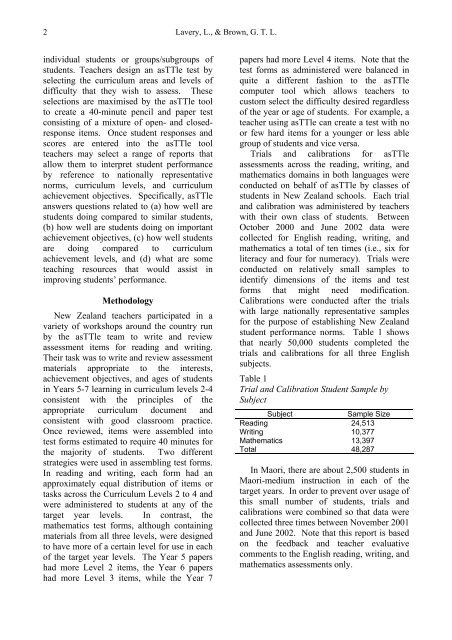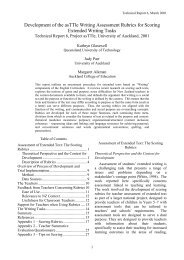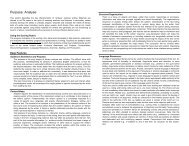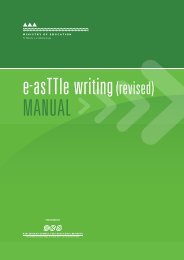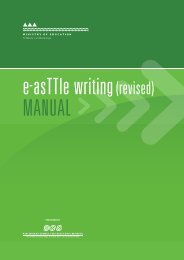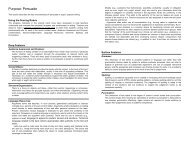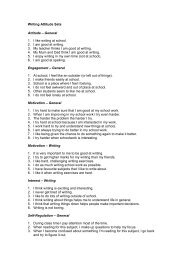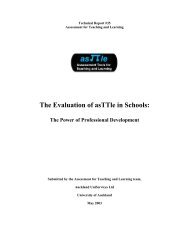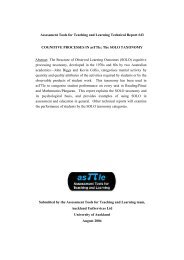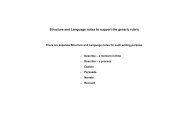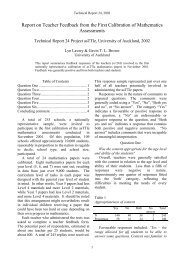33. Overall Summary of Teacher feedback from ... - e-asTTle
33. Overall Summary of Teacher feedback from ... - e-asTTle
33. Overall Summary of Teacher feedback from ... - e-asTTle
You also want an ePaper? Increase the reach of your titles
YUMPU automatically turns print PDFs into web optimized ePapers that Google loves.
2 Lavery, L., & Brown, G. T. L.individual students or groups/subgroups <strong>of</strong>students. <strong>Teacher</strong>s design an <strong>asTTle</strong> test byselecting the curriculum areas and levels <strong>of</strong>difficulty that they wish to assess. Theseselections are maximised by the <strong>asTTle</strong> toolto create a 40-minute pencil and paper testconsisting <strong>of</strong> a mixture <strong>of</strong> open- and closedresponseitems. Once student responses andscores are entered into the <strong>asTTle</strong> toolteachers may select a range <strong>of</strong> reports thatallow them to interpret student performanceby reference to nationally representativenorms, curriculum levels, and curriculumachievement objectives. Specifically, <strong>asTTle</strong>answers questions related to (a) how well arestudents doing compared to similar students,(b) how well are students doing on importantachievement objectives, (c) how well studentsare doing compared to curriculumachievement levels, and (d) what are someteaching resources that would assist inimproving students’ performance.MethodologyNew Zealand teachers participated in avariety <strong>of</strong> workshops around the country runby the <strong>asTTle</strong> team to write and reviewassessment items for reading and writing.Their task was to write and review assessmentmaterials appropriate to the interests,achievement objectives, and ages <strong>of</strong> studentsin Years 5-7 learning in curriculum levels 2-4consistent with the principles <strong>of</strong> theappropriate curriculum document andconsistent with good classroom practice.Once reviewed, items were assembled intotest forms estimated to require 40 minutes forthe majority <strong>of</strong> students. Two differentstrategies were used in assembling test forms.In reading and writing, each form had anapproximately equal distribution <strong>of</strong> items ortasks across the Curriculum Levels 2 to 4 andwere administered to students at any <strong>of</strong> thetarget year levels. In contrast, themathematics test forms, although containingmaterials <strong>from</strong> all three levels, were designedto have more <strong>of</strong> a certain level for use in each<strong>of</strong> the target year levels. The Year 5 papershad more Level 2 items, the Year 6 papershad more Level 3 items, while the Year 7papers had more Level 4 items. Note that thetest forms as administered were balanced inquite a different fashion to the <strong>asTTle</strong>computer tool which allows teachers tocustom select the difficulty desired regardless<strong>of</strong> the year or age <strong>of</strong> students. For example, ateacher using <strong>asTTle</strong> can create a test with noor few hard items for a younger or less ablegroup <strong>of</strong> students and vice versa.Trials and calibrations for <strong>asTTle</strong>assessments across the reading, writing, andmathematics domains in both languages wereconducted on behalf <strong>of</strong> <strong>asTTle</strong> by classes <strong>of</strong>students in New Zealand schools. Each trialand calibration was administered by teacherswith their own class <strong>of</strong> students. BetweenOctober 2000 and June 2002 data werecollected for English reading, writing, andmathematics a total <strong>of</strong> ten times (i.e., six forliteracy and four for numeracy). Trials wereconducted on relatively small samples toidentify dimensions <strong>of</strong> the items and testforms that might need modification.Calibrations were conducted after the trialswith large nationally representative samplesfor the purpose <strong>of</strong> establishing New Zealandstudent performance norms. Table 1 showsthat nearly 50,000 students completed thetrials and calibrations for all three Englishsubjects.Table 1Trial and Calibration Student Sample bySubjectSubjectSample SizeReading 24,513Writing 10,377Mathematics 13,397Total 48,287In Maori, there are about 2,500 students inMaori-medium instruction in each <strong>of</strong> thetarget years. In order to prevent over usage <strong>of</strong>this small number <strong>of</strong> students, trials andcalibrations were combined so that data werecollected three times between November 2001and June 2002. Note that this report is basedon the <strong>feedback</strong> and teacher evaluativecomments to the English reading, writing, andmathematics assessments only.


